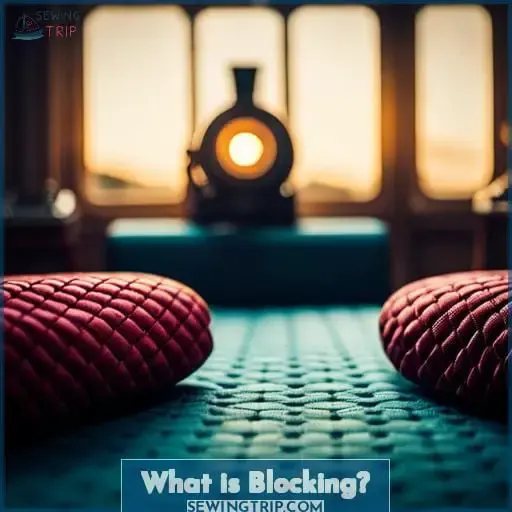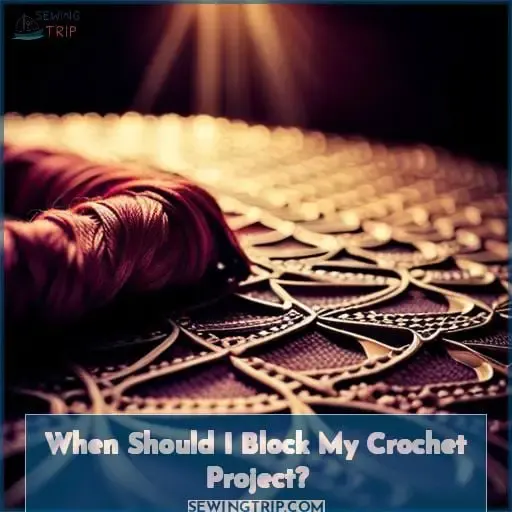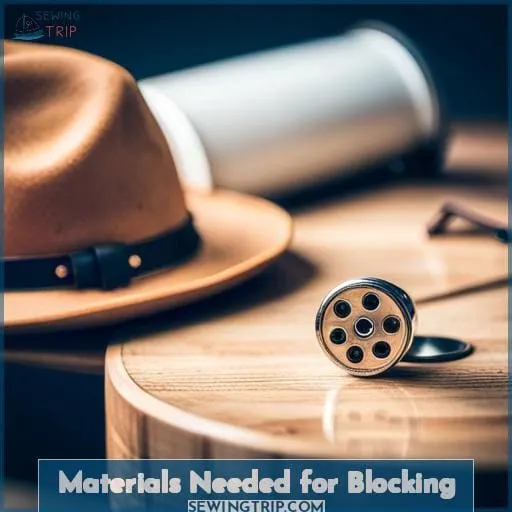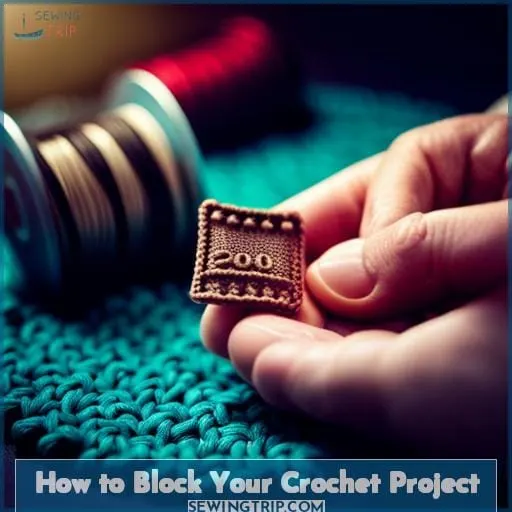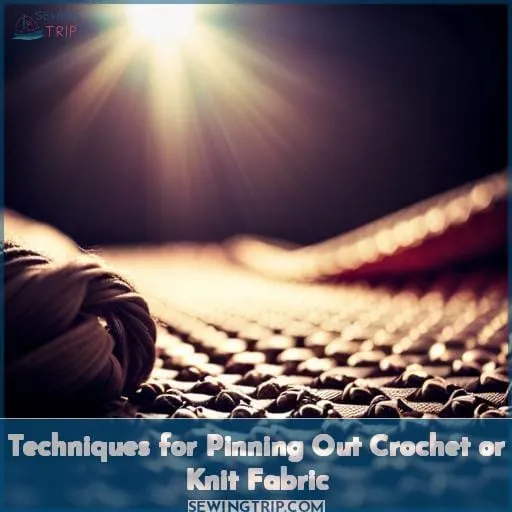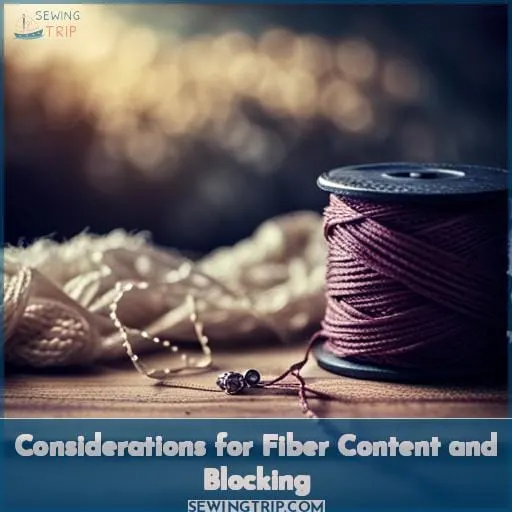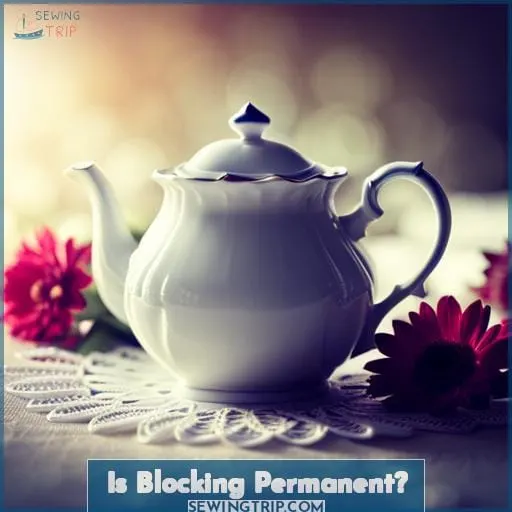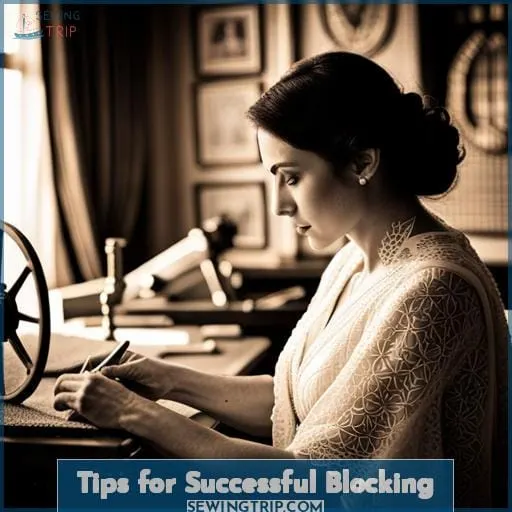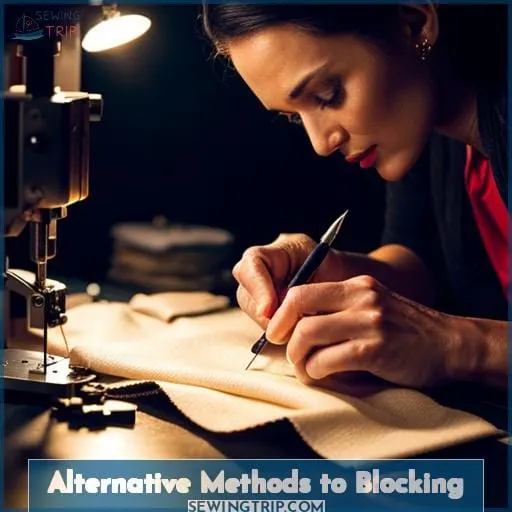This site is supported by our readers. We may earn a commission, at no cost to you, if you purchase through links.
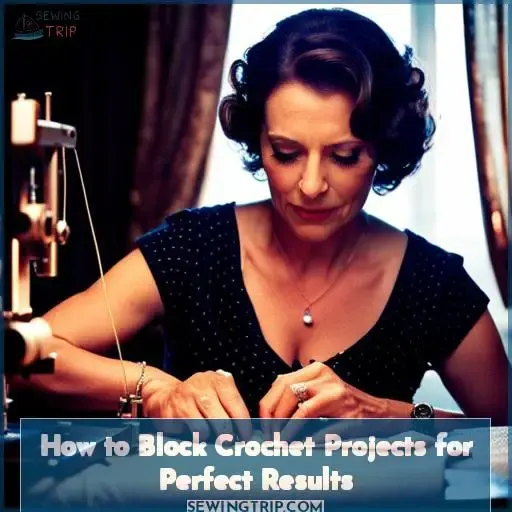 Struggling to get perfect results from your crochet project? You’re not alone. According to a survey by the Craft Yarn Council, nearly two-thirds of crocheters have trouble blocking their projects correctly.
Struggling to get perfect results from your crochet project? You’re not alone. According to a survey by the Craft Yarn Council, nearly two-thirds of crocheters have trouble blocking their projects correctly.
It can be daunting and intimidating, but don’t worry – it doesn’t have to be that way! This article will show you how to block crochet projects for optimal results every time with tips on materials needed, techniques used and alternative methods if necessary.
Table Of Contents
- Key Takeaways
- What is Blocking?
- When Should I Block My Crochet Project?
- Materials Needed for Blocking
- How to Block Your Crochet Project
- Techniques for Pinning Out Crochet or Knit Fabric
- Considerations for Fiber Content and Blocking
- Is Blocking Permanent?
- Tips for Successful Blocking
- Alternative Methods to Blocking
- Conclusion
Key Takeaways
- Blocking is crucial for enhancing the shape, drape, and appearance of crocheted projects.
- There are different blocking methods to choose from, such as soaking, steam blocking, and spray blocking.
- Proper fiber considerations are important for successful blocking, including wool, cotton, acrylic, silk, and alpaca fibers.
- It is important to avoid common blocking mistakes, such as uneven stretching, premature moving of the project, and leaving imprints in the fibers.
What is Blocking?
You’re getting those stitches all aligned and in shape by blocking your latest project. Blocking is the process of preparing your finished crochet or knitting project to enhance its shape, drape, and appearance.
It evens out the stitches, smooths curling edges, opens up the fabric’s lacework holes and lace patterns, and allows yarns to bloom for better drape and definition. Though often used for lace patterns and garments, blocking benefits all stitch types and projects.
While an optional finishing step for some pieces, blocking is essential for others, especially intricate lace shawls or fitted garments. Don’t fall for blocking myths – it won’t ruin your projects if done properly. With the right techniques and materials, you can unlock blocking’s transformative powers for your projects.
When Should I Block My Crochet Project?
Blocking is an important final step when finishing crochet projects. Many items benefit from blocking, including swatches, to help them hold their shape, lie flat, and enhance the drape of the fabric before sewing in ends.
Blocking helps reveal the beauty of stitch patterns and brings out the full potential of a project. Although blocking is often associated mostly with knitting, crocheted items also benefit tremendously.
Blocking allows the fibers to relax and sets the stitches in place. It helps even out individual stitches and smooths the overall appearance of the fabric. Swatches, garments, accessories, blankets, and lace projects all deserve a good blocking.
The exact method varies depending on the yarn fiber and stitches used, but generally involves lightly steaming or soaking the project and then pinning or shaping it to dry. Always check the yarn label for specific recommendations. Be sure to allow adequate drying time before use.
Blocking makes a huge difference in the finished look and professionalism of a crocheted piece.
Projects That Benefit From Blocking
Lacy garments love a good blocking before showing off their delicate details. Blocking lends professional results by revealing a project’s full potential. For intricate crochet and heavy or intricate knitting patterns that tend to curl, relaxing distorted stitches through steam blocking is helpful.
Items made from plant fibers and wool shine after a soak and pinning. Creative enhancements transform handmade pieces into runway-worthy works.
Blocking Swatches
Before starting your next knitting or crochet project, try blocking a swatch first. Blocking a swatch allows you to test how your chosen yarn and pattern stitch will look after blocking. Prepare swatches using the same yarn, needles or hook, and stitches you plan to use for your project.
Wet block the swatch the same way you would block the finished item. Observe any changes in the swatch’s dimensions and drape after blocking. Troubleshoot any issues with your planned stitches or yarn on this small scale. Blocking swatches informs decisions for your larger project and can improve your final results.
With practice, knowing how to properly block your work becomes intuitive. Blocking swatches gives you valuable information and can improve your knitting and crochet outcomes.
Blocking Before Sewing in Ends
Friend, it’s best to block your crochet piece before sewing in those loose ends.
- Measurements become more accurate.
- Stitches open up fully.
- Drape improves.
- Fibers relax into position.
Blocking your work provides maximum control for placing perfect finishing touches. Relaxed fibers glide smoothly through the needle’s eye. Precise placement prevents puckering.
Materials Needed for Blocking
Blocking is an important finishing technique for crochet projects that improves the drape, appearance, and texture of finished pieces. To properly block your work, you’ll need the right materials on hand, including blocking boards, T-pins, yarn needles, towels, and access to water, depending on your chosen method: soaking, spritzing, or steaming.
Soaking Blocking
Yet soaking your work in water beautifully tightens those stitches. But blocking this way requires planning. Lay your piece flat to dry, which takes time and space. Consider your schedule, project size, and fibers used before deciding to soak.
Have blocking materials ready beforehand too. Potential mistakes like colors bleeding or pieces stretching shouldn’t stop you. Follow blocking guides carefully, work slowly, and check frequently. With care, your soaked blocked piece will look polished.
| Blocking Method | Pros | Cons |
|---|---|---|
| Soaking | Gets into stitches, shapes fabric nicely | Long drying time, may bleed colors |
| Steaming | Quick, less fiber disruption | Less effective on some fibers |
| Spritzing | Gentle, lower bleeding risk | Needs reshaping while drying |
You need careful planning before soaking. Lay the piece flat with adequate drying time and space. Get blocking materials ready ahead as well. Follow guides slowly and check often. Errors like bleeding colors or distorted shapes can occur but don’t deter you. Taken carefully, soaking gives a tightened, polished result.
Spritz Blocking
Although more time consuming, a good steam press works wonders on stabilizing blocked pieces. Pinning out wet fabric onto a blocking mat gives you precise control over shaping. Consider fiber type when determining amount of moisture for blocking. Acrylics only need a light spritz before pinning to expand stitches.
Let pieces fully dry before removing pins for crisp edges. Natural fibers require heavier misting or soaking prior to reshaping. Mastering proper pinning techniques allows for perfectly blocked finished projects.
Steam Blocking
To achieve a smooth and polished finish to your crochet or knitting projects, you can use steam blocking. Steaming allows you to shape and define stitches without fully soaking your project. Benefits include opening up lace patterns, flattening seams, and easing fabric. With the right tools, a garment steamer or iron provides an easy blocking alternative to wet methods.
Follow tips like testing fabrics and sections first. Proper technique ensures quality results.
How to Block Your Crochet Project
There are a few techniques for properly blocking your finished crochet projects to maximize shape and enhance drape. We will walk through the processes for soaking blocking, spritzing blocking, and steam blocking to shape and set your stitches.
Blocking helps relax the fibers in your crocheted fabric and allows the stitches to settle into their final positions. Proper blocking makes the overall drape of the fabric smooth and flatters the intended shape of the piece.
The method you choose depends on the fiber content and structure of your project.
For soaking, fully submerge your project in a basin or sink filled with tepid water. Let it soak for at least 30 minutes to allow the fibers to become completely saturated. Gently squeeze out the excess moisture, do not wring or twist. Lay your project on a towel and pat into the intended shape.
Pin out the edges and leave to dry completely. This softens acrylic and plant-based yarns beautifully.
Spritzing with water is ideal for pieces made with animal fibers like wool. Lightly mist your project on both sides using a spray bottle. Smooth and shape the piece with your hands, then use rustproof pins to block as desired.
Let air dry fully before removing pins. The moisture allows the stitches to relax without full saturation.
Steam blocking applies heated moisture to set your work. Hold an iron or steamer a few inches above the project and apply steam across the top. Do not press down with the iron. Stretch and pin your crocheted item into the correct dimensions as you work.
Be sure your work is entirely dry before moving or using to prevent distorting stitches.
Step-by-Step Guide for Soak Blocking
You’d be surprised how relaxing a good soak can be for your latest crochet blanket. Carefully submerge your project in a bath of cool water and wool wash. Gently agitate, then let soak for 20-30 minutes.
Roll the project in a towel to remove excess moisture. Lay it flat on a blocking surface and pin it to finished measurements. Allow it to fully dry before removing the pins. Blocking opens up the fibers and evens the stitches, transforming your work into a polished piece.
Step-by-Step Guide for Spritz Blocking
Lay the piece out flat. Give it a good misting with water. Then use your blocking tools to shape it. Spritz blocking allows quicker shaping of fibers without full soaking. Mist lightly, reshape, and let dry fully.
Avoid over-wetting, and gently pat into shape rather than stretching excessively. Allow proper drying time to set the blocked shape. For best results, spritz block complicated lace or colorwork where soaking risks distortion.
Step-by-Step Guide for Steam Blocking
Experience the magic of steam by dancing with misty tendrils that unleash your project’s true colors and shape, as if conjuring a rainbow from vapor. Steam blocking relaxes fibers for defined stitches. Gently hover the iron above the project, taking care not to flatten texture.
Move slowly to evenly penetrate the steam. Let it dry fully before handling. Blocking opens patterns and evens edges for a professional finish.
Techniques for Pinning Out Crochet or Knit Fabric
When blocking your latest crochet or knit project, you’ll need to pin the fabric to a stable surface for shaping. Use rustproof pins and a blocking board, flexible wires that can mold fabric contours, or a peg board with movable pegs to gently stretch and pin pieces without damaging delicate yarn.
Consider using rustproof pins and a blocking board, flexible wires that can shape fabric contours, or a peg board with movable pegs. This allows you to gently stretch and pin pieces without damaging delicate yarn.
Using Pins and a Blocking Board
Capture your handmade magic with rainbow knit blockers, gripping your work securely as you unveil its true potential. Blocking maximizes drape and appearance by setting the stitches in place. Use pins on a blocking board to gently encourage the fabric into shape.
Experiment with techniques to control fullness and refine the final product. Embark on any project and transform it into a masterpiece.
Blocking Wire
Shape your project with flexible stainless steel blocking wires for precise lines. First, position the wires along edges and curves before inserting pins. Bend the wires to mold the fabric into the desired shape.
For blocking knits, weave the wires through the stitches. The wires hold their shape better than pins alone. Customize the shaping with gentle curves or sharp angles. Blocking wires provide rigid structure to open and lacy fabrics.
Blocking Peg Boards
Snag a peg board for flattening your finished crochet and knitted pieces quicker than pins. These wooden or plastic boards with grids of pegs let you shape damp fabrics taut. Simply stretch damp creations over the pegs to dry into precise geometries, with crisper stitches and straighter edges.
Peg boards achieve consistent blocking results as the pegs space fabrics evenly. They streamline large projects, minimizing pinning labor and accelerating finishing stages. Simplify your workflow with this clever tool, elevating your handmade heirlooms.
Considerations for Fiber Content and Blocking
When blocking your crochet or knit projects, it is crucial to consider the fiber content, as different fibers require diverse blocking techniques. For instance, natural fibers such as wool and cotton gain from wet blocking to relax the stitches and shape the fabric, whereas synthetic acrylic may only require a light steam press.
Choose a blocking technique appropriate for each fiber to properly establish the dimensions and form of your handcrafted creations.
Importance of fiber content
Know your fiber before blocking to avoid stretching out those handmade sweaters. Different fibers require different blocking techniques. Wool and acrylic yarns need steam or wet blocking to maintain shape without overstretching.
More delicate materials like silk, bamboo, and alpaca shouldn’t be wet blocked as this could ruin the fabric. Always review a yarn’s care instructions. Choosing the right blocking method for specific fibers takes time but can extend a project’s life.
Blocking techniques for different fibers
You’ll want to soak acrylic pieces before blocking since that fiber doesn’t absorb water well, while wool responds best to steam blocking. Silk and linen can be aggressively blocked by soaking and pinning while stretching.
Alpaca and cotton need more gentle handling like steam blocking to avoid damage.
Blocking for shape and size
You can reshape most projects to your desired measurements by gently pinning and steaming.
- Pin the project to the blocking surface and stretch/compress it to the size wanted.
- Use steam from an iron or garment steamer to set the fibers.
- Allow it to fully dry before removing the pins.
- Re-steam if needed to hold the shape.
- Check the measurements to confirm size accuracy.
Is Blocking Permanent?
Many crafters wonder if blocking is permanent or if a project will need to be reblocked over time. The truth is that blocking can last for years if done properly, but it’s not necessarily permanent. Natural fibers like wool and cotton will hold their blocked shape the longest, while acrylics are more prone to stretching back out eventually.
However, you likely won’t need to reblock for at least a few years, if not longer.
The key is to allow ample drying time when initially blocking to help set the fibers. With care, your beautiful blocked projects can maintain their shape for seasons to come. Gentle re-steaming or washing is all that’s typically needed for refreshing later on.
So don’t worry, your time spent blocking will pay off for the long haul.
Tips for Successful Blocking
Blocking is an essential part of many fiber crafts, but it can be daunting for beginners. To help you steer clear of common mistakes, here are some tips for triumphant blocking as a new crafter. Be attentive to the fibers you’re employing, take your time, and don’t fear making tweaks – with practice your blocking talents will get better.
Blocking Tips for Beginners
Instead, try blocking smaller pieces first to build confidence before tackling larger projects. Pinning smaller pieces lets new blockers practice techniques without wasted materials. Master hand sewing blocking with washcloths or swatches before blankets. Smaller pieces mean quicker blocking and faster results to evaluate and improve methods.
Don’t fear blocking mistakes initially. Let small pieces be learning opportunities for tools, techniques, and benefits before advancing skills.
Common Mistakes to Avoid
Here’s how to skip common blocking mistakes for frustration-free finishing. Avoid uneven stretching by gently easing fabric into shape. Let pieces dry fully before moving them to prevent deformation. Check pin and wire placement to avoid imprints on the fabric.
Carefully steam block synthetics, applying heat gradually. Using the correct tools and techniques prevents headaches and perfects results.
Alternative Methods to Blocking
Blocking is an essential part of many knitting and crochet projects, but traditional wet blocking isn’t always ideal. Consider alternative methods like dry blocking or stretch blocking for fabrics that can’t get wet or need a stretched shape.
Dry Blocking
Lay those washed pieces flat, darling – we’ll have this project looking gorgeous in no time.
- Some Benefits of Dry Blocking:
- Eliminates oils and dirt
- Flattens and shapes fibers
- Removes wrinkles
- Ensures accurate measurements
- Use dry blocking for delicate fibers like silk and linen that should not get wet. Let pieces fully dry before moving or handling them to avoid distortion. For best results, block individual pieces before assembling them.
Stretch Blocking
Wet yarn for stretch before shaping. Custom blocking boards let you achieve perfect shapes for delicate fabrics. Focus your blocking challenges on creatively using stretch techniques like bending wire knit blockers.
Conclusion
Blocking crochet projects is essential for finishing them and can make the difference between a handmade project that looks handmade or one that looks professional. With an estimated 500 million crochet projects made each year, it’s important to understand the techniques and materials for blocking.
There are various ways to block crochet and knit projects, depending on the fiber and desired look.
By understanding the importance of blocking, the materials required, and how to block crochet projects step-by-step, you can ensure your projects always look perfect. With just a few simple steps, you can take your crochet from handmade to professional quickly.

